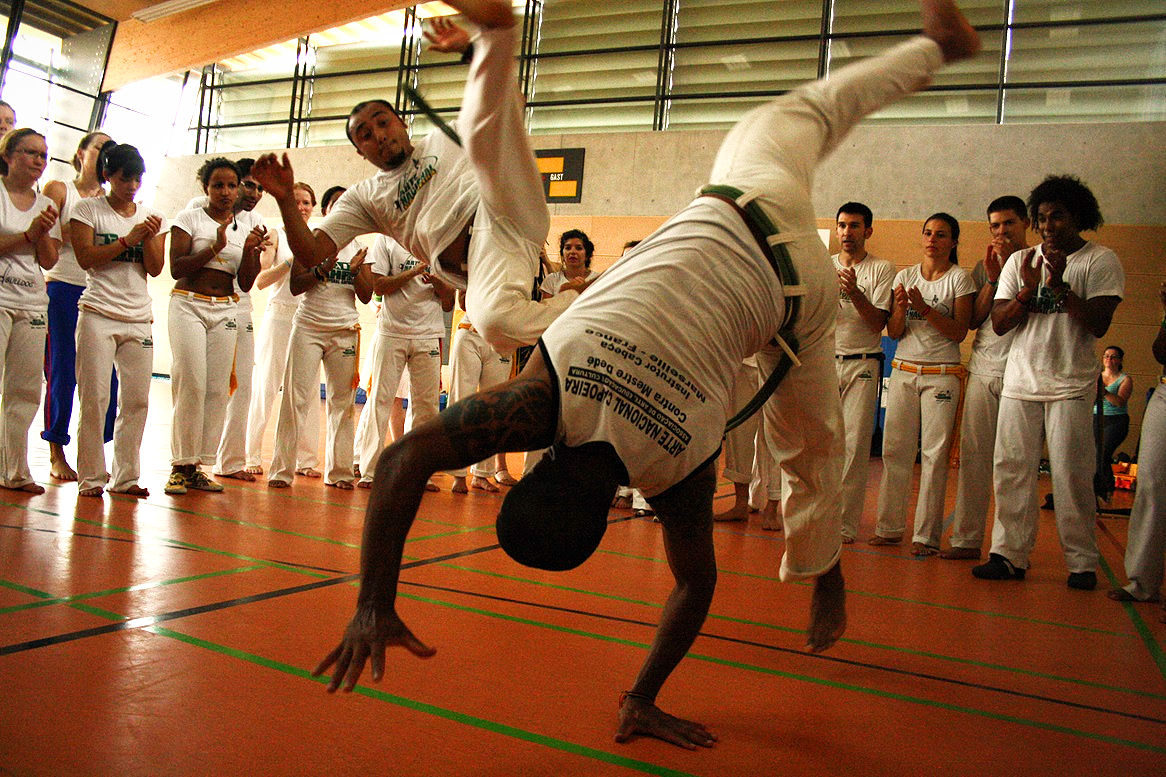What is Capoeira?
How Did Capoeira Originate?
.jpg)
Bild Quelle: https://www.kathbern.ch
Capoeira is a unique Afro-Brazilian art form that combines martial arts, dance, acrobatics, music, and ritual. Originating in Brazil in the 16th century, it was developed by enslaved Africans and their descendants as a means of self-defense, cultural preservation, and spiritual freedom.
With its flowing movements, rhythmic music, and deep-rooted traditions, Capoeira is more than just a martial art—it is living history, resistance, and expression all at the same time.
Capoeira was developed by African communities in Brazil, particularly from regions such as Angola and Congo. To defy oppression, practitioners disguised their martial art in dance-like movements accompanied by music and song—a sophisticated camouflage that protected both body and mind.
Capoeira was suppressed and criminalized for a long time, and its practice was forbidden – but it survived through its adaptability and unwavering community spirit, and is now a UNESCO World Heritage Site.

Related Afro-Brazilian traditions
Capoeira is part of a cultural universe. Other Afro-Brazilian forms of expression often flow into it:
-
Maculelê
An energetic stick dance accompanied by drums and call-and-response chants. Originally from the sugarcane plantations, maculelê is now an integral part of many capoeira performances. -
Samba de Roda
A traditional Brazilian dance, closely related to Capoeira, which is also danced in a circle (Roda) and celebrates joie de vivre, femininity and rhythm. -
Puxada de Rede
A theatrical play with singing that depicts the life of fishermen on the Brazilian coast – often performed as a cultural element in Capoeira festivals.

What is Capoeira?

Fight and dance
In Capoeira, players meet in flowing, improvised combative movements in the Roda – sometimes playful, sometimes challenging, but always in dialogue.
Capoeira combines the physical expressiveness of dance with the efficiency of fighting techniques in an incomparable way.
This connection not only promotes physical fitness, coordination and mobility, but also a deep sense of rhythm and musical understanding.
Enjoy a completely new body feeling.

Music and improvisation
The roda is a circle of people making music. The rhythm of the music sets the tempo and mood of the performance. In the roda, you have the space to express yourself creatively—not just through movement in sync with your partner. You also have the opportunity to improvise while making music yourself.
Get into the groove.

Open to all
Whether you are a child, a beginner, or an experienced fighter – you are welcome to join us!
The training is led by Master Dedé and other professional instructors. Beginners and those attending the trial session are always paired with an advanced student.
We respect different levels of fitness and specific limitations.
Practice martial arts in a respectful, friendly atmosphere.
Music and Groove
Music is the heart of capoeira. It is far more than just accompaniment: it sets the rhythm, the intensity, and even the meaning of the game. Without music, there is no capoeira roda.
In capoeira, a lively dialogue develops—between bodies, instruments, and voices. Music guides movement, tells stories, and conveys values, emotions, and community.
The most important instruments (at Arte Nacional)
-
Berimbau
The central instrument of capoeira is a musical bow with a calabash (cabaça) as a resonator.
There are three types:-
Gunga (deep) – leads the rhythm
-
Médio (medium) – stabilized
-
Viola (high) – improvised
-
-
Pandeiro
A tambourine-like frame drum, versatile and popular in samba and capoeira. -
Atabaque
A stand drum, the heart of the roda, bringing rhythmic depth and grounding. -
Agogo
Two metal or wooden bells striking in a high-pitched duet.
Capoeira songs
Songs are usually in Portuguese and sung in a question-and-answer style—a lead singer calls out, and the group responds. This way, students learn a new language along the way. Students can also write their own songs.
There are different song types (Arte Nacional has the most):
-
Ladainha – a long opening song with reflection or story before the start of the Roda
-
Corrido – often short, repetitive refrains during the game
The lyrics are often vivid. The songs are about:
-
History & Resistance (e.g. Zumbi, slavery, repression)
-
Nature & Everyday Life
-
Capoeira teachings and philosophies
-
Humor, irony & challenge
Find our music in the media page.



What Capoeira traditions and styles are there?
Capoeira has evolved over time into several styles – each with its own rhythm, character and focus:
-
Capoeira Regional
In the 1930s, Mestre Bimba developed a more structured training system and a faster, more athletic style of play. Regionally, he combined technique with discipline and made capoeira officially recognized for the first time in Brazil. Mestre Bimba achieved the abolition of the capoeira ban. A well-known group in the Stuttgart area is the Filhos de Bimba. -
Capoeira Angola
To distinguish it from the regional style, Mestre Pastinha coined the term "Capoeira Angola." A traditional capoeira form with deep, slow movements, plenty of cunning (malícia), and a strong focus on ritual and culture. He emphasized capoeira as a game of intelligence, elegance, and respect—not merely physical combat.
A group in the Stuttgart area are the Filhos de Angola -
Contemporary Capoeira
A modern, free style that combines elements from Angola and the region. It often incorporates acrobatics, creative movements, and influences from other arts—an expression of Capoeira's global development. We, Arte Nacional Capoeira, are a well-known group in the Stuttgart area.
We teach all three different styles. Master Dedé is well-versed in all three styles, but guest teachers ensure authentic teaching. Related traditions are also taught.



